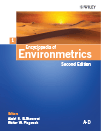Computer Modeling
Otto Richter, Ralf Seppelt, Dagmar Söndgerath,
Dagmar Söndgerath
Technical University of Braunschweig, Germany
Search for more papers by this authorOtto Richter, Ralf Seppelt, Dagmar Söndgerath,
Dagmar Söndgerath
Technical University of Braunschweig, Germany
Search for more papers by this authorFirst published: 15 September 2006
Abstract
The starting point of computer modeling is the design of a conceptual model. The conceptual model aggregates our knowledge of the system and implies a thorough (albeit subjective) selection of components and processes judged essential for the processes under study in a given spatiotemporal context. A conceptual model is graphically presented in form of a compartment system. Compartments are defined with respect to morphology and to physical, chemical and biological states. A computer model implies the translation of a conceptual model into a code, i.e. an algorithm.
References
- 1 Cressie, N.A.C. (1991). Statistics for Spatial Data, Wiley, New York.
- 2 Deutsch, C.V. & Journel, A.G. (1992). GSLIB – Geostatistical Software Library and User's Guide, Oxford University Press, New York.
- 3 Ermentrout, G.B. & Edelstein-Keshet, L. (1993). Cellular automata approaches to biological modelling, Journal of Theoretical Biology 160, 97–133.
- 4 Zadeh, L.A. (1965). Fuzzy sets, Information and Control 8, 338–353.
- 5 Heuvelink, G.B.M. (1998). Uncertainty analysis in environmental modelling under a change of spatial scale, Fertilizer Research 50, 255–266.
- 6 Wolfram, S. (1999). Mathematica Book, 4th Edition, Cambridge University Press, Cambridge.
- 7 Arrowsmith, D.K. & Place, C.M. (1994). Dynamic Systems, Spectrum, Heidelberg.
- 8
Seppelt, R. &
Temme, M.-M.
(2001).
Hybrid low level petri-nets in environmental modelling – development platform and case studies, in
Integrative Systems Approaches to Natural and Social Sciences,
M. Matthies,
H. Malchow &
J. Kriz, eds,
Springer-Verlag,
Berlin.
10.1007/978-3-642-56585-4_13 Google Scholar
- 9 Heller, U. & Struss, P. (1997). Conceptual Modelling in the Environmental Domain, Scientific Computation, Modelling and Applied Mathematics, 15th IMACS (International Association for Mathematics and Computers in Simutation) World Congress, Berlin.
- 10 Hulbert, L., Peterson, S., Wallis, J. & Richmond, B. (2000). Stella Research Software Manual, MM High Performance System Inc., Hanover.
- 11 Walker, A. (1994). ModelMaker, Cherwell Scientific Publishing, Oxford.
- 12 Hairer, E. & Wanner, G. (1983). Solving Ordinary Differential Equations, Vol. 2, Springer-Verlag, Berlin.
- 13 Hairer, E., Nørsett, S.P. & Wanner, G. (1980). Solving Ordinary Differential Equation Systems, Vol. 1, Springer-Verlag, Berlin.
- 14 Schittkowski, K. (1994). Parameter estimation in systems of nonlinear equations, Numerische Mathematik 69, 129–142.
- 15 Seppelt, R. (2001). Hierarchical dynamic programming and applications in ecosystem management, Environmental Modelling and Software 16, 377–386.
- 16 Richter, O. & Söndgerath, D. (1990). Parameter Estimation in Ecology – The Link between Data and Models, VCH Verlag, Weinheim.
- 17 Draper, N.R. & Smith, H. (1966). Applied Regression Analysis, Wiley, New York.
- 18 Marsili-Libelli, S. (1992). Parameter estimation of ecological models, Ecological Modelling 62, 233–258.
- 19
Seber, G.A.F. &
Wild, C.J.
(1989).
Nonlinear Regression,
Wiley,
New York.
10.1002/0471725315 Google Scholar
- 20 Kelpin, F.D.L., Kirkilionis, M.A. & Kooi, B.W. (2000). Numerical methods and parameter estimation of a structured population model with discrete events in the life history, Journal of Theoretical Biology 207, 217–230.
- 21 Gubbins, S. & Gilligan, C.A. (1996). Population dynamics of a parasite and hyperparasite in a closed system: model analysis and parameter estimation, Proceedings of the Royal Society of London, Series B 263, 1071–1078.
- 22 Foley, P. (2000). Problems in extinction model selection and parameter estimation, Environmental Management 26, Supplement 1, S55–S73.
- 23 Salski, A. (1992). Fuzzy knowledge-based models in ecological research, Ecological Modelling 63, 103–112.
- 24 Wall, M. (1996). A C++ Library of Genetic Algorithm Components, Massachusetts Institute of Technology, Mechanical Engineering Department.
- 25 Rawls, W.J. & Brakensiek, D.L. (1985). Prediction of soil water properties for hydrologic modelling, in Proceedings of the Symposium ‘Watershed Management in the Eighties’, Denver, pp. 293–299.
- 26 Tietje, O. & Tapkenhinrichs, M. (1993). Evaluation of pedo-transfer functions, Soil Science Society of America Journal 57, 1088–1095.
- 27 Kermack, W.O. & McKendrick, A.G. (1927). Contributions to the mathematical theory of epidemics, Proceedings of the Royal Society, Series A 115, 700 ff.
- 28 Seppelt, R. (2000). Regionalised optimum control problems for agroecosystem management, Ecological Modelling 131, 121–132.
- 29 Breuning, M. (1996). Integration of Spatial Information for Geo-Information Systems, Lecture Notes in Earth Sciences, Vol. 61, Springer-Verlag, Berlin.
- 30 Richter, O. (1998). Pesticides, environmental fate, in Encyclopedia of Environmental Analysis and Remediation, R.A. Meyers, ed., Wiley, Chichester, pp. 3484–3505.
- 31 Struss, P. & Heller, U. (1998). Process-oriented Modelling and Diagnoses – Revising and Extending the Theory of Diagnosis from First Principles, Working Notes of 9th International Workshop on Principle Diagnoses, Sea Crest Cape Cod.



